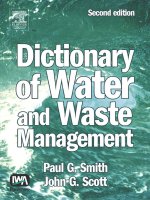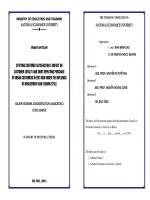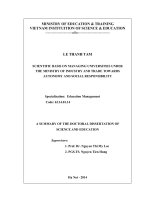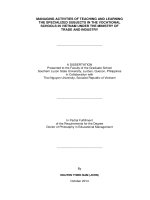Nutrient uptake under inter-cropping systems of ginger and cowpea and weed management practices
Bạn đang xem bản rút gọn của tài liệu. Xem và tải ngay bản đầy đủ của tài liệu tại đây (324.58 KB, 13 trang )
Int.J.Curr.Microbiol.App.Sci (2018) 7(11): 2858-2870
International Journal of Current Microbiology and Applied Sciences
ISSN: 2319-7706 Volume 7 Number 11 (2018)
Journal homepage:
Original Research Article
/>
Nutrient Uptake under Inter-Cropping Systems of Ginger and Cowpea and
Weed Management Practices
A. Baruah1* and J. Deka2
1
Dow Agro Sciences India Pvt. Ltd., Kolkata-700157, West Bengal, India
2
Assam Agricultural University, Jorhat-785013, Assam, India
*Corresponding author
ABSTRACT
Keywords
Nutrient uptake, Intercropping, Weed
management, Hand
weeding, Metribuzin,
Oxadiargyl, Rhizome
Article Info
Accepted:
22 October 2018
Available Online:
10 November 2018
A field experiment was conducted in Assam Agricultural University, Jorhat district,
Assam, India to understand the effectiveness of inter-cropping system and chemical weed
management on nutrient uptake by ginger (Zingiber officinale Rosc.), inter-crop and
weeds, during 2013-14 and 2014-15. There were 16 numbers of treatment combinations,
comprising of 4 inter-cropping systems and 4 weed management practices. Intercropping
of Cowpea in between rows of Ginger and incorporated at 40 days after sowing (DAS) and
treatment with Metribuzin 500 g ai ha -1 + hand weeding (HW) at 70, 100 and 140 days
after planting (DAP) recorded better results in terms of crop yield and nutrient uptake by
ginger and cowpea. On the contrary, weedy check recorded the highest nutrition uptake by
weeds at almost all the considered time intervals. At the time of ginger harvest, treatments
Ginger + Cowpea (2:1) and Cowpea incorporated at 40 DAS and Hand weeding (HW) at
40, 70, 100 and 140 DAP recorded better results in terms of P 2O5 and K2O availability in
soil.
Introduction
In India, Ginger (Zingiber officinale Rosc.) is
considered to be a high valued commercial
crop due to its multipurpose uses. Also, India
is one of the major producer and consumer of
ginger, accounting for about 30-40% of the
global share of production, followed by China,
Nepal and Indonesia (Gracy et al., 2013). But
ginger is an exhaustive crop, therefore nutrient
availability and uptake is critical for its
production. Due to wider spacing, it faces
severe competition for nutrition from weeds.
Growing of intercrops and application of preemergence herbicide can be an effective
approach towards better nutrient uptake by
ginger, its enhanced growth and yield due to
effective weed management. The current study
was undertaken with the intent to understand
the impact of inter-crops and chemical weed
management on nutrient uptake by crops and
weeds and yield of ginger.
Materials and Methods
Soils characteristics
Prior
to
initiating
the
experiment,
representative soil samples were collected
randomly and analysed for their chemical
2858
Int.J.Curr.Microbiol.App.Sci (2018) 7(11): 2858-2870
properties. The texture of the soil was found to
be sandy loam with acidic in reaction. For
both the years i.e. 2013-14 and 2014-15,
available Nitrogen (N) and Potassium (K2O)
were in medium range whereas Phosphorus
(P2O5) was low. A detail description of
chemical properties of the soil and methods
used are presented in Table 1.
plots at 60 and 100 DAP, except the Weedy
plots. Need based plant protection measures
were adopted to manage pests and diseases as
per package and practices recommended by
Assam Agricultural University. In both the
years, cowpea was uprooted and incorporated
in the soil on the 40th day after sowing and
ginger crop was harvested on the 262nd day
after planting in both the years.
Treatment details
Results and Discussion
There were 16 treatment combinations
comprising of 4 Cropping Systems viz., I1:
Ginger + Cowpea (2:1); Cowpea incorporated
at 40 DAS, I2: Ginger + Cowpea (3:1);
Cowpea incorporated at 40 DAS, I3: Cowpea
in between rows of Ginger and incorporated at
40 DAS, I4: Cowpea in between alternate rows
of Ginger and incorporated at 40 DAS and 4
Weed Management Practices viz., W1: Weedy
(Control), W2: Hand weeding at 40, 70, 100
and 140 DAP, W3: Pre-emergence application
of Oxadiargyl 90 g ai ha-1 + hand weeding at
70, 100 and 140 DAP and W4: Pre-emergence
application of Metribuzin 500 g ai ha-1 + hand
weeding at 70, 100 and 140 DAP.
Planting/sowing
operations
and
inter-cultural
The ginger variety ‘Nadia’ pre-treated with
Mancozeb were planted in a spacing of 60 cm
between two rows and 25 cm between
rhizomes. The number of ginger rows was as
per the row ratios in the cropping system
treatments. A short duration fodder variety of
cowpea ‘UPC-278’ was sown as an inter-crop
as per the treatment requirement. The
herbicides, Metribuzin and Oxadiargyl were
applied with a spray volume of 500 l ha-1 on
the 3rd day after planting of ginger rhizomes.
The plots were mulched with rice straw @ 4 t
ha-1 in two splits, one immediately after
planting of ginger and second at 70 DAP.
Light earthing up of ginger was done in all the
Effect on yield of crops
In 2013-14 and 2014-15, treatment Cowpea in
between Ginger and incorporated at 40 DAS
recorded significantly higher fresh biomass
weight of cowpea whereas weed management
with Metribuzine 500 g ha-1 pre-em+ HW 70,
100 and 140 DAP recorded significantly
higher fresh biomass weight of cowpea in both
the years (Table 2).
Intercropping of Cowpea in between Ginger
and incorporated at 40 DAS recorded highest
ginger yield of 7542 kg ha-1in 2013-14 and
8633 kg ha-1 in 2014-15. It was statistically at
par with the treatment Cowpea in alternate
rows and incorporated at 40 DAS. Application
of Metribuzine 500 g ha-1 pre-em+ HW 70,
100 and 140 DAP recorded significantly
higher ginger yield of 7817and 9340kg ha-1 in
2013-14 and 2014-15, respectively as
compared to other weed management
treatment (Table 2).
Effect on nutrient uptake by crops
In both the years of experimentation, highest
Nitrogen (N) uptake of 98.8 kg ha-1 (2013-14)
and 114.7 kg ha-1 (2014-15) by ginger was
recorded in the treatment Cowpea in between
Ginger and incorporated at 40 DAS. It was
statistically at par with the treatment Cowpea
in alternate rows and incorporated at 40 DAS.
Highest Phosphorus (P) uptake by ginger was
2859
Int.J.Curr.Microbiol.App.Sci (2018) 7(11): 2858-2870
also recorded in the treatment Cowpea in
between Ginger and incorporated at 40 DAS,
which recorded uptake of 11.5 kg ha-1 in
2013-14 and 13.3 kg ha-1 in 2014-15, but it
was statistically at par with the treatment
Cowpea in alternate rows and incorporated at
40 DAS. A similar trend was also observed in
respect of Potassium (K) uptake by ginger.
Inter-cropping system Cowpea in between
Ginger and incorporated at 40 DAS recorded
the highest K uptake of 108.5 and 118.4 kg ha1
in 2013-14 and 2014-15, respectively which
was at par with the treatment Cowpea in
alternate rows and incorporated at 40 DAS
(Table 3). Thus, in both the years,
intercropping treatment Cowpea in between
Ginger and incorporated at 40 DAP recorded
highest nutrient uptake by ginger. Better
biomass production by ginger under this
intercropping system due to better weed
smothering at the critical stage of competition
and N fixation by legume cowpea and its
incorporation might have increased the
nutrient uptake (Willey, 1979).
Amongst the weed management practices,
Metribuzine 500 g ha-1 pre-em + HW 70, 100
and 140 DAP recorded significantly higher N
uptake of 106.8 kg ha-1 in 2013-14 and 128.1
kg ha-1 in 2014-15 by ginger. This treatment
also recorded significantly higher P uptake of
12.4 and 14.9 kg ha-1 in 2013-14 and 2014-15,
respectively as compared to other weed
management treatments. K uptake of 113.2
and 121.7 kg ha-1 in 2013-14 and 2014-15,
respectively by ginger was also recorded in
Metribuzine 500 g ha-1 pre-em + HW 70, 100
and 140 DAP (Table 3), which was
significantly higher than other weed
management. Nutrient uptake in Metribuzin
treated plots were followed by the treatment
Oxadiargyl 90 g ha-1 pre-em + HW 70, 100
and 140 DAP. Metribuzin application
followed by 3 hand weeding created a
sustained competition free environment for
better growth of ginger finally contributing
towards increased nutrient uptake by the crop.
Similar, results are reported by Sathiyavani
and Prabhakaran (2015) also in turmeric.
Intercropping of Cowpea in between Ginger
and incorporated at 40 DAS, recorded
significantly higher uptake of N, P and K by
cowpea as compared to all other cropping
systems (Table 4). This might be due to the
closer row spacing which created an ideal
weed free condition. It contributed towards
better biomass production leading to higher
nutrient uptake by cowpea.
Weed management with Metribuzine 500 g ha1
pre-em + HW 70, 100 and 140 DAP
recorded significantly higher uptake of N, P
and K by cowpea than rest of the weed
management treatments (Table 4). It was
followed by the treatment Oxadiargyl 90 g
ha-1 pre-em + HW 70, 100 and 140 DAP. Preemergence application of those two herbicides
resulted effective weed control during the
critical phases, thus helping better nutrient
uptake by the inter-crop cowpea.
Table.1 Chemical properties of surface soil at experimental site
Particular(s)
(kg ha -1)
Value(s)
Method adopted
2013-14
2014-15
Available N
Available P2O5
Available K2O
388.0
17.8
239.4
369.40
13.8
252.3
Kjeldahl Method (Jackson, 1973)
Bray-I Method (Jackson, 1973)
Flame Photometric Method (Jacson,1973)
2860
Int.J.Curr.Microbiol.App.Sci (2018) 7(11): 2858-2870
Table.2 Fresh biomass weight of cowpea and rhizome yield of ginger (kg ha-1)
Treatment
Cowpea biomass weight
(kg ha-1)
2013-14
2014-15
Ginger rhizome yield
(kg ha-1)
2013-14
2014-15
Cropping system
I1: G*+C* (2:1); C incorp. 40 DAS
4679
4523
5846
6175
I2: G+C (3:1); C incorp. 40 DAS
3656
3729
5925
6454
I3: C in between G; incorp. 40 DAS
14333
10158
7542
8633
I4: C in alternate rows; incorp. 40 DAS
9229
7458
7338
8505
CDP=0.05
448
305
419
635
W1: Weedy
7796
6196
5021
4825
W2: HW 40, 70, 100 and 140 DAP
7563
6108
6533
7396
W3: Oxadiargyl 90 g ha-1 pre-em+ HW 70, 100 and 140 DAP
8043
6606
7279
8208
W4: Metribuzine 500 g ha-1 pre-em+ HW 70, 100 and 140
DAP
CDP=0.05
8497
6958
7817
9340
448
305
338
635
Weed management
G*=Ginger,
C* Cowpea,
pre-em=Pre-emergence
2861
Int.J.Curr.Microbiol.App.Sci (2018) 7(11): 2858-2870
Table.3 Nutrient (N, P and K) uptake by ginger (kg ha-1)
N (kg ha-1)
P (kg ha-1)
K (kg ha-1)
201314
2014-15
201314
2014-15
201314
201415
I1: G*+C* (2:1); C incorp. 40 DAS
66.7
71.1
8.2
8.7
72.2
76.7
I2: G+C (3:1); C incorp. 40 DAS
67.6
74.1
8.3
9.1
73.2
80.0
I3: C in between G; incorp. 40 DAS
98.8
114.7
11.5
13.3
108.5
118.4
I4: C in alternate rows; incorp. 40 DAS
96.1
113.0
11.2
13.1
105.6
116.5
CDP=0.05
4.3
2.4
0.5
0.3
4.6
4.5
W1: Weedy
40.1
38.5
5.5
5.3
52.7
50.7
W2: HW 40, 70, 100 and 140 DAP
83.2
94.4
9.8
11.1
88.7
100.7
W3: Oxadiargyl 90 g ha-1 pre-em+ HW 70, 100 and 140 DAP
99.1
111.9
11.5
13.0
105.0
118.5
W4: Metribuzine 500 g ha-1 pre-em+ HW 70, 100 and 140 DAP
106.8
128.1
12.4
14.9
113.2
121.7
CDP=0.05
4.3
4.1
0.5
0.3
4.6
4.5
Treatments
Cropping system
Weed management
G*=Ginger,
C* Cowpea,
pre-em=Pre-emergence
2862
Int.J.Curr.Microbiol.App.Sci (2018) 7(11): 2858-2870
Table.4 Nutrient (N, P and K) uptake by cowpea (kg ha-1)
N (kg ha-1)
Treatments
P (kg ha-1)
K (kg ha-1)
201314
2014-15
201314
2014-15
201314
201415
I1: G*+C* (2:1); C incorp. 40 DAS
44.0
41.5
6.7
6.4
54.0
52.3
I2: G+C (3:1); C incorp. 40 DAS
34.3
35.1
5.2
5.3
42.0
43.0
I3: C in between G; incorp. 40 DAS
160.3
111.2
21.9
15.6
195.0
137.2
I4: C in alternate rows; incorp. 40 DAS
106.7
82.8
14.1
11.2
127.1
100.2
4.4
2.6
0.4
0.5
3.9
3.6
W1: Weedy
79.8
63.0
11.5
9.1
94.4
74.5
W2: HW 40, 70, 100 and 140 DAP
79.0
62.1
11.1
9.0
91.6
73.5
W3: Oxadiargyl 90 g ha-1 pre-em+ HW 70, 100 and 140 DAP
90.1
70.7
12.3
10.1
114.8
91.1
W4: Metribuzine 500 g ha-1 pre-em+ HW 70, 100 and 140 DAP
94.7
74.7
12.9
10.7
119.4
94.8
CDP=0.05
4.4
2.6
0.4
0.5
3.9
3.6
Cropping system
CDP=0.05
Weed management
G*=Ginger,
C* Cowpea,
pre-em=Pre-emergence
2863
Int.J.Curr.Microbiol.App.Sci (2018) 7(11): 2858-2870
Table.5 Nitrogen (kg ha-1) uptake by weeds
Treatments
2013-14
2014-15
40
70
DAP DAP
100
DAP
130
DAP
160
DAP
40
70
100
DAP DAP DAP
130
DAP
160
DAP
Cropping system
I1: G*+C* (2:1); C incorp. 40 DAS
23.2
55.2
72.5
84.5
87.4
20.7
49.7
66.9
78.7
82.9
I2: G+C (3:1); C incorp. 40 DAS
23.3
47.0
62.0
71.7
75.8
20.9
42.3
57.2
66.8
70.8
I3: C in between G; incorp. 40 DAS
13.5
28.4
38.6
47.4
50.3
12.1
24.9
37.1
43.6
46.1
I4: C in alternate rows; incorp. 40 DAS
15.0
31.6
41.8
49.5
52.3
13.6
28.1
36.1
45.6
48.4
CDP=0.05
2.0
1.4
2.6
2.2
2.7
1.0
1.4
1.8
2.9
3.4
Weed management
W1: Weedy
35.1
103.6 131.3 150.5 155.0
29.1
96.3
123.6 142.6 148.5
W2: HW 40, 70, 100 and 140 DAP
20.8
21.1
30.1
37.0
39.5
30.0
17.9
26.8
33.6
36.2
W3: Oxadiargyl 90 g ha-1 pre-em+ HW 70, 100 and 140 DAP
11.0
19.4
27.5
33.7
36.5
9.9
16.1
24.2
30.5
33.2
W4: Metribuzine 500 g ha-1 pre-em+ HW 70, 100 and 140 DAP
8.0
18.1
26.0
31.8
34.7
6.9
14.8
22.8
27.9
30.4
CDP=0.05
2.0
1.4
2.6
2.2
2.7
1.0
1.4
1.8
2.9
3.4
G*=Ginger,
C* Cowpea,
pre-em=Pre-emergence
2864
Int.J.Curr.Microbiol.App.Sci (2018) 7(11): 2858-2870
Table.6 Phosphorus (kg ha-1) uptake by weeds
Treatments
2013-14
2014-15
40
70
100 130 160
40
70
100 130 160
DAP DAP DAP DAP DAP DAP DAP DAP DAP DAP
Cropping system
I1: G*+C* (2:1); C incorp. 40 DAS
3.27
7.4
9.8
11.5
12.1
3.0
6.6
9.0
10.7
11.3
I2: G+C (3:1); C incorp. 40 DAS
3.50
6.4
8.5
9.8
10.4
3.0
5.7
7.7
9.1
9.7
I3: C in between G; incorp. 40 DAS
2.00
3.8
5.2
6.4
6.8
1.8
3.3
4.8
5.7
6.2
I4: C in alternate rows; incorp. 40 DAS
2.16
4.1
5.6
6.7
7.0
2.0
3.7
4.8
6.1
6.5
CDP=0.05
0.28
0.2
0.5
0.4
0.5
0.2
0.2
0.4
0.4
0.5
W1: Weedy
4.13
12.2
15.4
17.7
18.4
3.5
11.3
14.4
16.8
17.4
W2: HW 40, 70, 100 and 140 DAP
3.53
3.6
5.1
6.2
6.8
3.7
3.0
4.5
5.6
6.1
W3: Oxadiargyl 90 g ha-1 pre-em+ HW 70, 100 and 140 DAP
1.76
3.1
4.4
5.4
5.8
1.5
2.5
3.9
4.8
5.3
W4: Metribuzine 500 g ha-1 pre-em+ HW 70, 100 and 140 DAP
1.51
2.9
4.0
5.1
5.4
1.4
2.4
3.5
4.5
4.9
CDP=0.05
0.28
0.2
0.5
0.4
0.5
0.2
0.2
0.4
0.4
0.5
Weed management
G*=Ginger,
C* Cowpea,
pre-em=Pre-emergence
2865
Int.J.Curr.Microbiol.App.Sci (2018) 7(11): 2858-2870
Table.7 Potassium (kg ha-1) uptake by weeds
Treatments
2013-14
2014-15
40
70
DAP DAP
100
DAP
130
DAP
I1: G*+C* (2:1); C incorp. 40 DAS
28.8
66.9
87.6
I2: G+C (3:1); C incorp. 40 DAS
29.4
55.4
I3: C in between G; incorp. 40 DAS
17.4
I4: C in alternate rows; incorp. 40 DAS
CDP=0.05
160
DAP
40
70
DAP DAP
100
DAP
130
DAP
160
DAP
103.2 108.6
25.8
60.3
81.4
96.2
101.6
73.6
85.4
89.6
26.2
49.8
67.4
79.3
84.4
34.7
46.6
58.5
61.2
15.6
30.5
45.3
53.7
56.1
19.4
37.3
53.4
61.0
63.7
17.6
32.7
43.8
55.4
59.1
2.5
1.6
3.4
2.8
2.9
1.2
1.5
1.8
3.0
4.3
Cropping system
Weed management
W1: Weedy
37.4
110.1 139.7 159.9 164.6
28.9
102.4 131.4 151.6 157.8
W2: HW 40, 70, 100 and 140 DAP
30.7
31.0
44.3
54.4
58.1
30.1
26.1
39.3
49.4
53.2
W3: Oxadiargyl 90 g ha-1 pre-em+ HW 70, 100 and 140 DAP
15.5
27.4
39.8
48.0
51.5
14.0
23.1
34.3
43.3
47.2
W4: Metribuzine 500 g ha-1 pre-em+ HW 70, 100 and 140 DAP
11.3
25.8
37.4
45.9
48.9
9.7
21.7
32.9
40.4
43.1
CDP=0.05
2.5
1.6
3.4
2.8
2.9
1.2
1.5
1.8
3.0
4.3
G*=Ginger,
C* Cowpea,
pre-em=Pre-emergence
2866
Int.J.Curr.Microbiol.App.Sci (2018) 7(11): 2858-2870
Table.8 Available nutrients (kg ha-1) in the soil at the time of cowpea incorporation
N (kg ha-1)
Treatments
P (kg ha-1)
K (kg ha-1)
201314
2014-15
201314
2014-15
201314
201415
I1: G*+C* (2:1); C incorp. 40 DAS
264.2
266.3
35.9
37.2
83.9
91.3
I2: G+C (3:1); C incorp. 40 DAS
255.5
270.4
29.3
30.7
76.2
82.0
I3: C in between G; incorp. 40 DAS
280.0
282.2
20.7
22.0
54.1
65.3
I4: C in alternate rows; incorp. 40 DAS
272.6
276.2
23.3
24.6
64.3
74.3
NS
NS
3.6
3.7
5.4
3.9
W1: Weedy
265.0
267.8
26.0
27.4
67.6
76.0
W2: HW 40, 70, 100 and 140 DAP
270.8
278.7
28.7
30.0
72.4
80.8
W3: Oxadiargyl 90 g ha-1 pre-em+ HW 70, 100 and 140 DAP
268.5
276.2
27.8
29.1
69.7
78.6
W4: Metribuzine 500 g ha-1 pre-em+ HW 70, 100 and 140 DAP
267.9
272.5
26.7
28.0
68.7
77.5
NS
NS
NS
NS
NS
NS
Cropping system
CDP=0.05
Weed management
CDP=0.05
G*=Ginger,
C* Cowpea,
pre-em=Pre-emergence
2867
Int.J.Curr.Microbiol.App.Sci (2018) 7(11): 2858-2870
Table.9 Available nutrients (kg ha-1) in the soil at the time of ginger incorporation
N (kg ha-1)
Treatments
P (kg ha-1)
K (kg ha-1)
201314
2014-15
201314
2014-15
201314
201415
I1: G*+C* (2:1); C incorp. 40 DAS
269.1
260.3
30.5
31.7
73.2
74.5
I2: G+C (3:1); C incorp. 40 DAS
264.8
257.1
26.3
27.6
67.0
68.4
I3: C in between G; incorp. 40 DAS
279.9
274.3
19.6
20.6
50.8
52.2
I4: C in alternate rows; incorp. 40 DAS
277.9
260.3
21.0
22.9
59.0
60.3
NS
NS
3.2
2.7
4.7
4.7
W1: Weedy
266.5
255.4
17.9
19.1
47.3
48.6
W2: HW 40, 70, 100 and 140 DAP
278.0
266.1
27.3
28.7
69.9
71.2
W3: Oxadiargyl 90 g ha-1 pre-em+ HW 70, 100 and 140 DAP
274.5
265.4
26.5
27.9
67.1
68.4
W4: Metribuzine 500 g ha-1 pre-em+ HW 70, 100 and 140 DAP
272.7
265.2
25.7
27.2
65.8
67.1
NS
NS
3.2
2.7
4.7
4.7
Cropping system
CDP=0.05
Weed management
CDP=0.05
G*=Ginger,
C* Cowpea,
pre-em=Pre-emergence
2868
Int.J.Curr.Microbiol.App.Sci (2018) 7(11): 2858-2870
Effect on nutrient uptake by weeds
In both the years of experimentation, highest
N uptake by weeds during initial phase (40
DAP) was recorded in the treatment Ginger +
Cowpea (3:1) and Cowpea incorporated at 40
DAS, which was at par with Ginger +
Cowpea (2:1) and Cowpea incorporated at 40
DAS. But at subsequent stages (70, 100, 130
and 160 DAP), significantly higher N uptake
was recorded in the treatment Ginger +
Cowpea (2:1) and Cowpea incorporated at 40
DAS. On the other hand, the lowest N uptake
was by weeds was recorded under Cowpea in
between Ginger and incorporated at 40 DAS
at all the stages in both the years (Table 5).
Highest P and K uptake was recorded at 70,
100, 130 and 160 DAP, respectively in the
treatment Ginger + Cowpea (2:1) and Cowpea
incorporated at 40 DAS. The treatment
Cowpea in between Ginger and incorporated
at 40 DAS recorded the lowest P and K
uptake by weeds at all the stages of
observation in both the years (Table 6 and 7).
Increasing intercrop density showed better
suppression of weeds resulting lower nutrient
uptake by weed.
Application of Metribuzine 500 g ha-1 preem+ HW 70, 100 and 140 DAP at all the
stages in both the years showed the lowest
uptake of N, P and K by weeds as compared
to the other weed management treatments
(Table 5, 6 and 7). The result trend of weed
density and weed dry weight resembled the
trend of uptake of different nutrients at
various stages of growth. This result is in
concomitance with the reports of Sathiyavani
(2014) in turmeric.
Effect on available nutrients in soil
Intercropping systems had no significant
effect on the available N in the soil at the time
of cowpea incorporation in both the years.
However, Ginger + Cowpea (2:1) and
Cowpea incorporated at 40 DAS resulted
significantly higher amount of P2O5 and K2O
at the time of cowpea incorporation in both
the years. Different weed management
practices had no effect on the available
nutrients in the soil at the time of cowpea
incorporation in both the years (Table 8).
Available N in the soil at the time of ginger
harvest in both the years of experimentation
was not impacted by the intercropping
systems. But significantly higher available
P2O5 and K2O was recorded in Ginger +
Cowpea (2:1) and Cowpea incorporated at 40
DAS in both the years in relation to other
cropping
systems.
Different
weed
management practices had no significant
effect on the available N in the soil at the time
of ginger harvest in both the years. Hand
weeding at 40, 70, 100 and 140 DAP recorded
highest available P2O5 in both the years.
Similarly, this treatment also recorded highest
available K2O at the time of ginger harvest
(Table 9). It might be due to lesser uptake of
nutrients by the crop as compared to
integrated weed management treatments using
pre-emergence herbicides.
References
Gracy, C. P.; Jyoti, N. J. and Nagashree, N.
(2013). Ginger price forecast - Store
and sell ginger. Agropedia.
Palaniappan, S. P. (1988). Cropping system in
the tropics. In: Principles and
Management. Wiley Eastern Limited,
New Delhi.
Sathiyavani, E. (2014). Evaluation of
integrated weed management with pre
and post emergence herbicides in
turmeric. Ph.D. Thesis. Directorate of
crop
management,
Tamil
Nadu
Agricultural University, Coimbatore.
Sathiyavani, E. and Prabhakaran, N. K.
(2015). Effect of integrated weed
management practices on plant height,
2869
Int.J.Curr.Microbiol.App.Sci (2018) 7(11): 2858-2870
number of tillers in turmeric during
kharif season. International Journal of
Horticulture 5(2): 1-8.
Willey, R. W. (1979). A scientific approach to
intercropping
research.
In:
The
Proceeding of the International
Workshop on Intercropping. ICRISAT,
Hyderabad, 10-13 Jan.
How to cite this article:
Baruah, A. and Deka, J. 2018. Nutrient Uptake under Inter-Cropping Systems of Ginger and
Cowpea and Weed Management Practices. Int.J.Curr.Microbiol.App.Sci. 7(11): 2858-2870.
doi: />
2870









